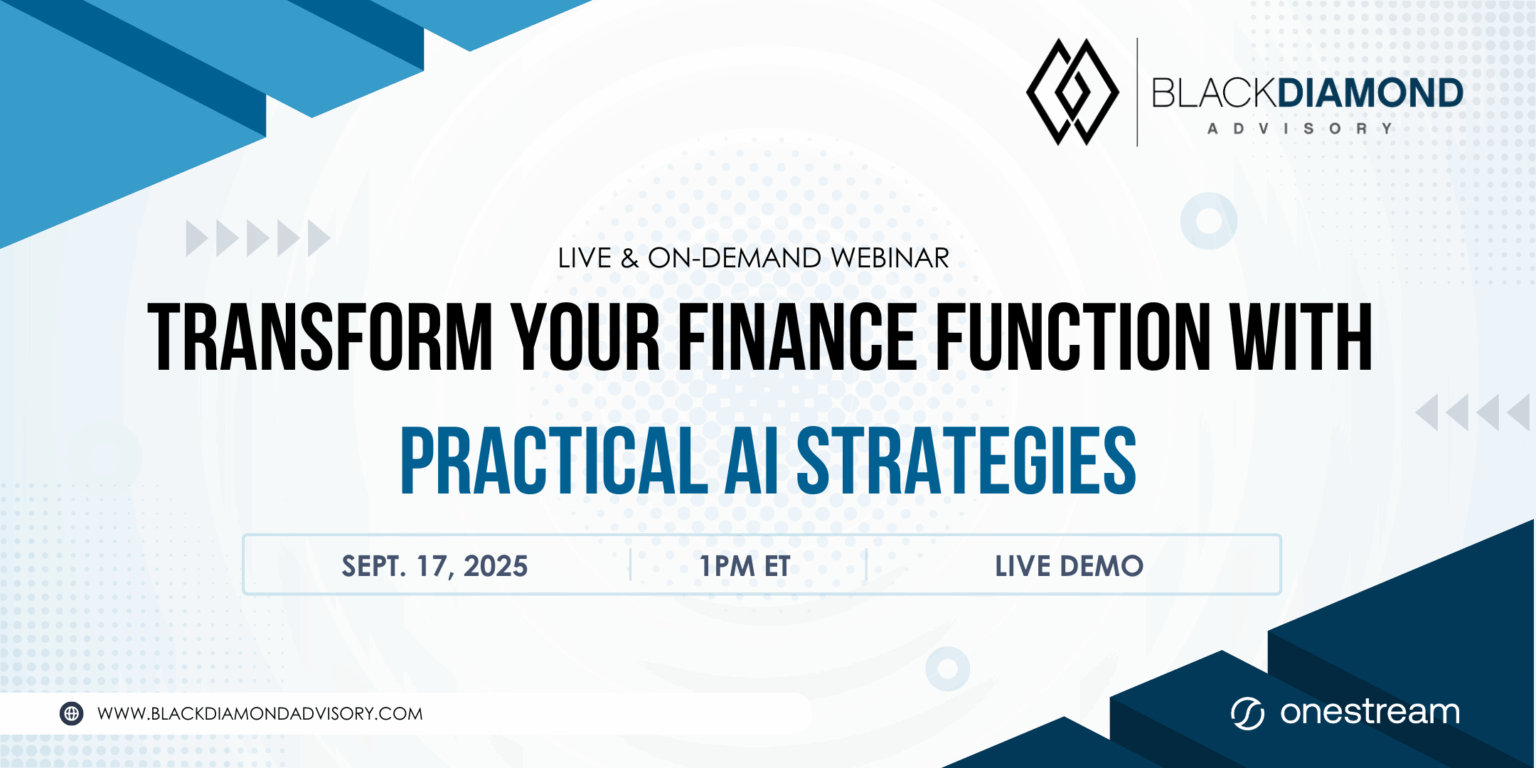All articles in this series:
- OneStream Power User Talks AI
- AI Transformation in Finance
- The Future of Finance: New Operating Models for the AI Era
- Practical Implementation: Making AI Real in Finance
- Beyond Point Solutions: Why Finance Intelligence Platforms Drive Transformative Value
The Real AI Challenge for Finance Leaders
Finance leaders are exhausted by the AI hype cycle. They’ve endured countless vendor presentations filled with technical jargon and grandiose promises, yet they’re still waiting for the “so what” that connects to their day-to-day challenges.
Despite 90% of companies launching digital transformation initiatives, only about a third are seeing the expected revenue benefits. Why this disconnect? We’re caught in what I call the “convergence gap” – the chasm between technical AI concepts and their practical business applications in finance.
IT departments speak one language, vendors speak another, and finance teams are left trying to translate how any of it addresses their specific challenges. This isn’t just frustrating – it’s expensive. Finance leaders are making multi-million-dollar technology decisions based on buzzwords rather than business outcomes.
Education Must Precede Implementation
Before defining a single AI requirement or evaluating a single vendor, your organization needs practical education on AI capabilities specific to finance processes. The shift needed is from asking “What is AI?” to “What can AI do for finance?”
Most finance teams are fixated on technical capabilities rather than business outcomes. Organizations regularly write RFPs for AI solutions before defining the business problem they’re trying to solve. This backward approach leads to failed implementations and wasted resources.
Think about it: you wouldn’t buy a car without understanding how it meets your transportation needs. Yet organizations invest millions in AI without understanding how it addresses their finance challenges.
Redefining AI for Finance: It’s About Operational Connectivity
Let me offer a more practical definition: In finance, AI is the technology that transforms data into decisions by connecting financial outcomes to operational drivers.
The real power of AI isn’t in automating individual tasks – it’s in connecting financial plans to operational execution. For too long, finance has operated in a silo, producing reports that tell what happened but struggling to influence what will happen. AI fundamentally changes this dynamic.
Traditional finance systems excel at capturing and reporting financial data but struggle to connect that data to operational realities. AI bridges this gap, creating “operational connectivity” – the ability to see how operational decisions impact financial outcomes and vice versa.
The Business Case: Beyond Simple Efficiency
The mistake most organizations make is viewing AI primarily as a cost-reduction tool. The real business case for AI in FP&A centers on four value drivers:
1. Decision velocity: AI significantly reduces the cycle time between planning and execution, compressing the entire decision cycle from weeks to days.
2. Forecast accuracy: Human-generated forecasts are persistently biased. AI provides an objective, data-driven baseline before human judgment is applied, improving forecast accuracy by up to 40%.
3. Operational connectivity: AI translates financial plans into operational actions and operational metrics into financial outcomes, bridging the finance-operations divide.
4. Resource optimization: Finance teams spend up to 70% of their time on low-value data collection and manipulation. AI automation shifts teams from 30/70 strategic-to-tactical work ratios to 70/30 ratios, transforming finance’s contribution to enterprise value.
The financial impact is measurable: organizations effectively deploying AI in FP&A see 25-30% higher EBITDA growth than their peers.
Where to Start: Three Practical Applications
Based on our work with hundreds of finance organizations, these three use cases deliver the highest ROI with the lowest implementation complexity:
1. Automated Baseline Forecasting: Establish data-driven forecasts as objective starting points, eliminating the “sandbagging” and bias that plague traditional forecasting.
2. Anomaly Detection for Variance Analysis: Stop wasting time hunting for variance causes. AI can identify patterns and outliers that explain variances faster and more accurately than manual analysis.
3. Driver-Based Planning Models: Move beyond simplistic allocation methods to sophisticated models that capture the true relationship between operational drivers and financial outcomes.
These applications deliver quick wins, build essential capabilities, and create immediate business value.
Avoiding Common Implementation Pitfalls
Technology implementations fail for predictable reasons. The three most common pitfalls in AI implementations are:
1. Starting with technology instead of business problems: Begin with the business outcome, not the technology.
2. Underestimating data readiness: AI doesn’t overcome data quality issues; it amplifies them. Assess your data foundation first.
3. Neglecting change management: AI implementation is about changing how people work. The technology is the easy part; changing behaviors and processes is where most implementations fail.
The most successful implementations follow a “foundational, progressive, advanced” approach: start with a narrowly defined use case, build capabilities and confidence, then expand to more complex applications.
The Future of Finance with AI
The finance function is evolving from a backward-looking reporting operation to a forward-looking decision partner. AI is accelerating this evolution by:
1. Enabling agentic finance workflows where AI actively manages processes and suggests decisions
2. Dissolving operational silos between finance, operations, and commercial teams
3. Redefining finance roles away from data gathering toward insight generation
This isn’t about replacing finance professionals; it’s about elevating them to higher-value activities.
Moving Forward
The journey from buzzwords to business outcomes requires a fundamental shift in how we approach technology adoption. It starts with education, centers on business problems rather than technical capabilities, and focuses relentlessly on measurable outcomes.
The organizations that take this approach will realize the true promise of AI in finance: the transformation of finance from scorekeeper to strategic business partner.
In our next article, we’ll dive deeper into the four transformative value drivers that make AI essential for tomorrow’s finance organizations.
—
Randy Werder is a recognized thought leader in finance transformation with over two decades of experience guiding global organizations through technology-enabled change. His straightforward, business-outcome focused approach has helped dozens of Fortune 500 companies successfully implement AI solutions in their finance operations.


